CC Adi 13.60 (1975)

A.C. Bhaktivedanta Swami Prabhupada
TEXT 60
- tāṅra patnī 'śacī'-nāma, pativratā satī
- yāṅra pitā 'nīlāmbara' nāma cakravartī
SYNONYMS
tāṅra patnī—his wife; śacī—of the name Śacī; nāma—named; pati-vratā—devoted to her husband; satī—chaste; yāṅra—whose; pitā—father; nīlāmbara—of the name Nīlāmbara; nāma—named; cakravartī—with the title Cakravartī.
TRANSLATION
His wife, Śrīmatī Śacīdevī, was a chaste woman highly devoted to her husband. Śacīdevī's father's name was Nīlāmbara, and his surname was Cakravartī.
PURPORT
In the Gaura-gaṇoddeśa-dīpikā, verse 104, it is mentioned that Nīlāmbara Cakravartī was formerly Garga Muni. Some of the family descendants of Nīlāmbara Cakravartī still live in the village of the name Magḍobā in the district of Faridpur in Bangladesh. His nephew was Jagannātha Cakravartī, also known as Māmu Ṭhākura, who became a disciple of Paṇḍita Gosvāmī and stayed at Jagannātha Purī as the priest of Ṭoṭā-gopīnātha. Nīlāmbara Cakravartī lived at Navadvīpa in the neighborhood of Belapukuriyā. This fact is mentioned in the book Prema-vilāsa. Because he lived near the house of the Kazi, the Kazi was also considered one of the maternal uncles of Lord Caitanya Mahāprabhu. The Kazi used to address Nīlāmbara Cakravartī as kākā, or "uncle." One cannot separate the residence of the Kazi from Vāmanapukura because the tomb of the Kazi is still existing there. Formerly the place was known as Belapukuriyā, and now it is called Vāmanapukura. This has been ascertained by archeological evidence.